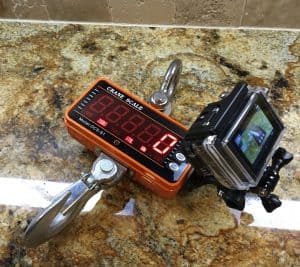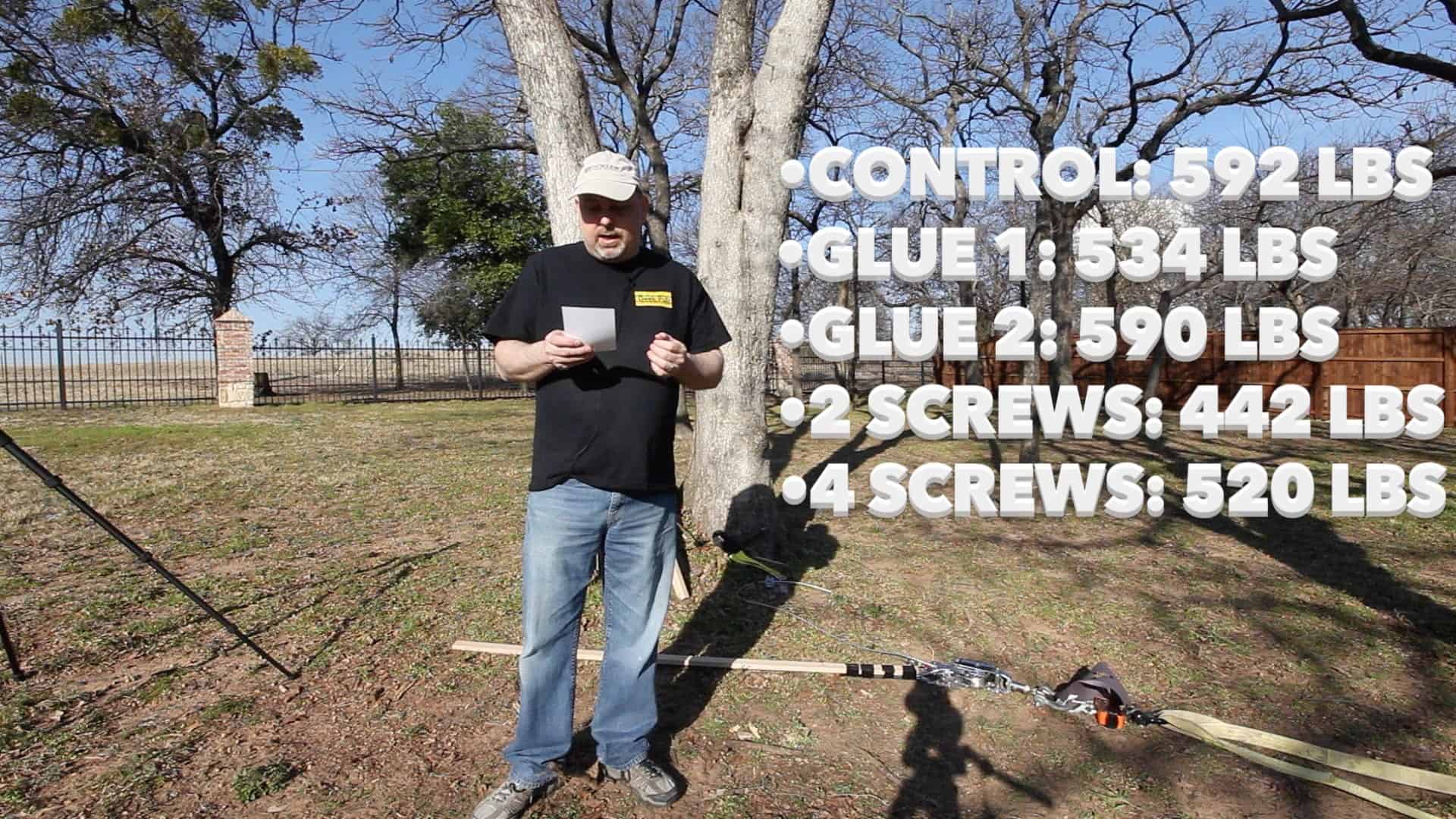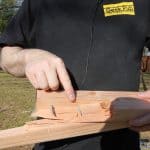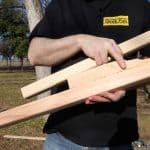Blog
Glue vs. Screws: Which one is stronger?

[adinserter name=”TopOfPost”]I post lots of projects. In most of these projects I use some type of fastener or glue to make a bond between two pieces of wood (or other material). Inevitably I get asked regularly in the comments on YouTube and here on my website why I used glue instead of “something stronger like screws”. Its somewhat fascinating really, because it almost always leads to some comment war on who’s right and who’s wrong. And almost never does either party have any evidence to back up their claim. Glue vs. screws is a common debate.
Well in this episode, the first of an all new series I am working on called Test Lab, we’re going to find out once and for all whether glue is stronger than screws! We’ll put both to the test and see what happens!
Glue vs. Screws: The Challenge
 In order to test whether glues or screws is stronger I first went to my local home improvement center and purchased several spruce 2x4s from the lumber section. I brought them home and ripped them into 2x2s on the table saw and cut them down to 3 foot long. I then overlapped all of the 2x2s by exactly twelve inches. I glued several of them together, used two screws on another set, and four screws on the last set.
In order to test whether glues or screws is stronger I first went to my local home improvement center and purchased several spruce 2x4s from the lumber section. I brought them home and ripped them into 2x2s on the table saw and cut them down to 3 foot long. I then overlapped all of the 2x2s by exactly twelve inches. I glued several of them together, used two screws on another set, and four screws on the last set.
In order to make 100% sure the glue was completely cured, I let it dry for two full weeks. If glue is to be the loser, I don’t want anyone to be able to say it needed longer to cure. According the Titebond II bottle it needs 24 hours to cure. I gave it 336 just to be safe. I did only leave it in the clamps for 24 hours though, in case you are wondering.
Glue vs. Screws: Measuring the Test
 The next step was to figure out a way to measure the force required to break the test boards. I decided to use a 1-ton crane scale from Klau. I wanted something that was affordable, and accurate. I also wanted something I could put in-line with my test, rather than having some type of scale I had to mount everything on top of.
The next step was to figure out a way to measure the force required to break the test boards. I decided to use a 1-ton crane scale from Klau. I wanted something that was affordable, and accurate. I also wanted something I could put in-line with my test, rather than having some type of scale I had to mount everything on top of.
The crane scale didn’t have a max limit hold function which means as soon as the weight is released the scale immediately returns to zero. To solve this problem I mounted a GoPro Hero 3 on the side of the scale. This would allow me to go frame by frame and capture the exact weight reading on the scale the millisecond that the board loses structural integrity.
I connected the crane scale using a tree saver strap from old four wheeling days. On the other end of the crane scale I attached a 4-ton come-along that would be used to apply the force to the wood.
Glue vs Screws: The Showdown
I found two trees in my backyard that I could easily wedge the samples behind, and not far from it was another tree I could use as the anchor point. This turned out to work better than excellent! I also attached a 6 ft long oak 1×2 to the handle of the come-along. This allowed me to stand out of the path of carnage, should a board break under extreme conditions that I was not prepared for.
Glue vs. Screws: The Control
The first test was a control board. This was a solid three foot long 2×2 that had never been bonded in any way. I wanted to do this to have a comparison later. This board lost structural integrity at 592 lbs.
Glue vs. Screws: The Glue
The second two tests were both with 2x2s that had been glued together, overlapping exactly twelve inches. I surprised how quickly the first test failed. As you can see on the video I was expecting a lot more. However, after checking the GoPro footage for the crane scale I realized it actually held more weight than I realized during the test. It failed at 534 lbs. The second glue board failed at 590 lbs. After inspecting the first board, it turns out that it had a knot hole, which resulted in early failure. Glad I had a redux ready!
Glue vs. Screws: The Screws
The last tests were with wood screws. I used three inch screws and pre-drilled the holes. This means the screws penetrated all the way through both boards, and did not crack or pre-stress them in any way. The first board had two screw and failed at 442 lbs. The second board had four screws and failed at 520 lbs. That’s a pretty respectable amount of force, almost approaching the glue!
Glue vs. Screws: The Winner
It’s no doubt that in this particular test, glue wins. Even with the knot hole making sample one fail somewhat early, glue still held over 33% more force before failing. 150 lbs of extra weight. That’s a significant advantage!
Another point to be aware of is how the bonds failed. In the case if the screw joints both samples failed at the screw joint itself. In both glue samples the boards actually lost structural integrity somewhere other than the actual glue joint. This means that the glue is actually stronger than the wood itself.
Video Transcript
Hey Guys! It’s Mike, from The Geek Pub! And on this episode we’re going to test what’s stronger: Glue or Screws!
OK. Well in order to determine whether wood glue or screws is stronger I have setup this come-along between these three trees, and I have got this crane scale that goes up to a full ton. That’s 2000 lbs. And I am going to put that in the loop so that we can measure how much weight gets applied or how much force is required to pull these boards apart, and I’ve got a Go Pro on here so that we can record that.
I have also put together several different pieces of wood. Attaching some of them with wood glue, and some of them with screws. But! We’re going to start with a control, and the control is nothing more than a 2×2. And we’re going to find out how much force it takes to break a wood, sorry, a solid piece of wood, before we even attempt to break the ones that been glued or screwed together, so that we have a baseline.
OK. So I have setup this really long bar as a safety measure, and that will allow me to stand clear of when the board breaks. And all I have to do is start tightening it up. We are at roughly 250 lbs. Now we’re at about 360 lbs. Still don’t hear any cracking. Ooh! And there we go!
OK! So now we’re going to test wood glue! And this is just two 2x2s that are overlapped by one foot and glued together. I let these dry for two weeks because I wanted to make sure this was a perfectly long-term bond. And so lets see what happens here. OK! We are at roughly 230 lbs. Wow! That uh, that broke way sooner than I expected. So uh, because of that, I actually made two of the exact ones. We’re going to test glue again.
OK. This is wood glue: test number two. And uh. I uh, hope this one takes a little more weight than the first one. OK. We are roughly at 256 lbs and I am already hearing some cracking. That’s not good. 346 lbs it looks like. 460 lbs this is much better than the first result. That’s why I always like to test things twice. OK. We’re at 500 and uh. Woops. Hang on. Nope. We’ve went down some. That means we’re probably about to fail. Yeah. That’s exactly what happened so. There we go.
This sample is two wood screws. And these wood screws are exactly the length of the board, so they go all the way through both boards. OK and we are roughly 182 lbs. Starting to hear some cracks… and… Check where we are. We are roughly at 348 lbs. and it broke.
OK. This is our last test. This is four wood screws. Same thing. Two 2x2s overlapped by exactly twelve inches. And I expect that we will have no better luck with this one. And uh. We’re not even at 200 lbs yet. Jumped the gun on that one. Again, this long arm keeps me out of the firing line should something go wrong. And we are now at 355 lbs. I hear cracking. And we are at uh, 520ish lbs. And its about to give. And there it goes.
OK. I went in the house. I wanted to take the GoPro footage out and I wanted to look at it frame by frame so I could find the exact number where the wood started to fail, because the wood actually took a higher strain and then broke, or it started cracking and losing some of its structural integrity and then broke at a lower weight. And so I wanted to find out what the absolute max that the board held before it started to buckle. And interestingly enough, so here it is. The first one with glue was 534 lbs. The second one with glue, and I think that one might have actually failed because of some flaws in the wood, we’ll look at that in just a second. The second one with wood glue broke at 590 lbs. Or lost structural integrity at 590 lbs. Here’s where it gets interesting. Two wood screws broke at 442 lbs and four wood screws broke at 520 lbs. Almost up to our glue standards. At least for the first uhm, for the first board. So lets take a look at a couple of things here. Both of the test with screws broke along the lines of where the screws penetrated the wood. And I think that’s very telling, because if you look at the glue samples, the glue bond is still one hundred percent intact. The uhm, the wood actually broke somewhere other than where it was glued together. Meaning that the glue joint is actually stronger than the wood itself. That’s interesting.
OK. So how do we call this? I think it’s pretty easy actually, because the samples with glue held about 150 lbs more weight before they started to fail than the ones with screws and that is about 33% stronger. So in this particular case, glue wins.
Well hey guys! Thank you so much for being a fan of my stuff! If you think I did something wrong in this video or you’d like to see me test it in a different way be sure to leave a comment below. And if you’re a fan of my stuff I’d really encourage you to hit that like button and subscribe to my channel. And if you want to be a big time fan you can help me out by click here and joining me as a patron on Patreon. And as always if you’re not following me on Facebook and Instagram, I post pictures of all of my projects as I am building them, so you get a sneak peak as we go along. See you in the next video!






You should test glue and screws.
I knew someone would ask that.
What brand of glue did you use
Titebond II
Omg! I’m trying to hang window blinds and can’t get the damn screw all the way into the window frame. So I thought to myself: is there an adhesive I could use instead? Voilà!! I found your webpage and got my answer. Thank you geek pub Murray!! I’ll let you know if they hold up. BJ
Thanks for the information. The glue is also not detectable from the outside of the boards, where screw heads are.
It shouldnt be a surprised that glue would come out the winner. But the real question is: is the strength provided by the screws only good enough for most purposes? Besides, doing with screws allows us to detach everything more cleanly if we need to.
4.5
I’ll second that. Also what about nails?
5
0.5
4